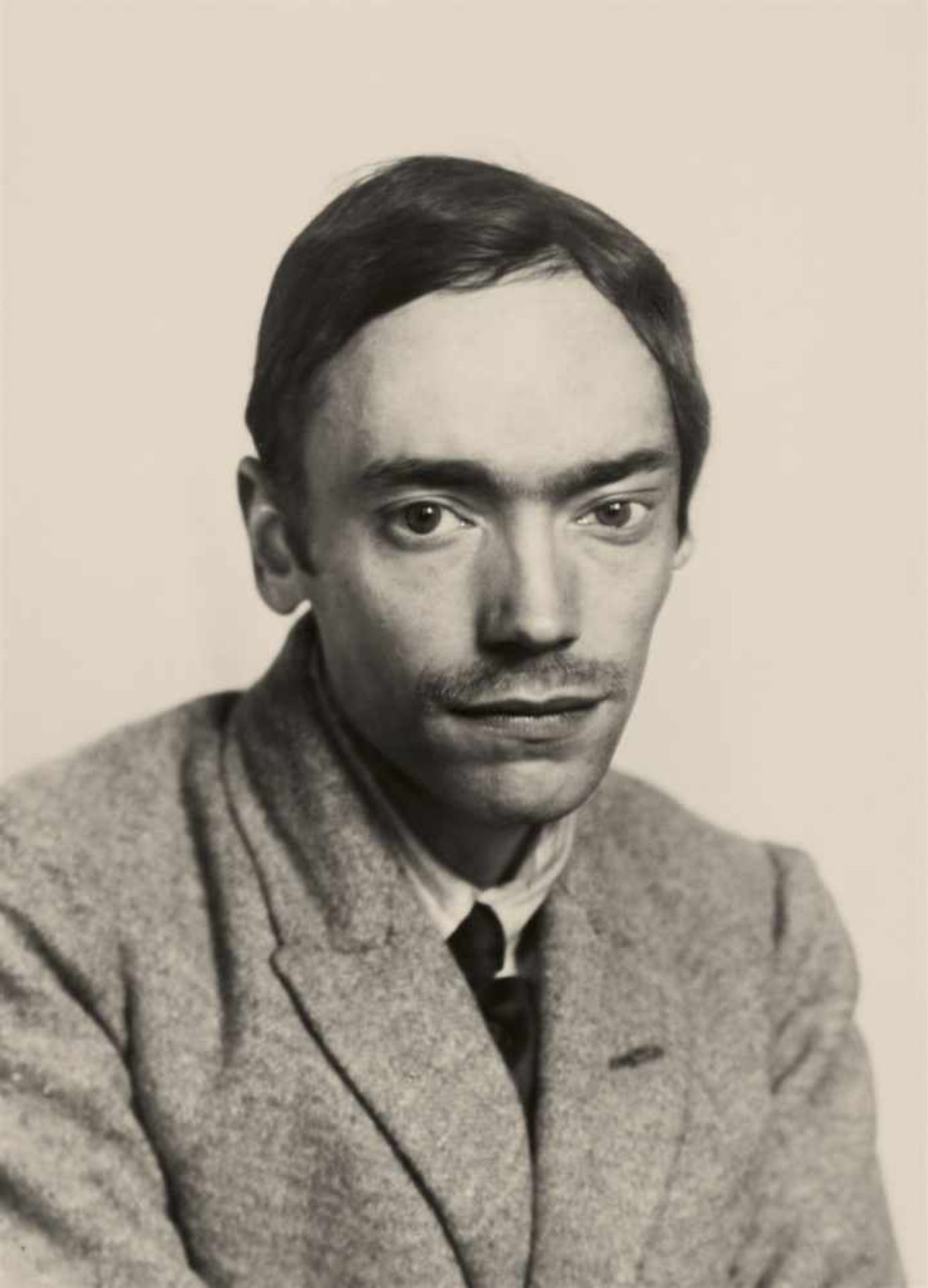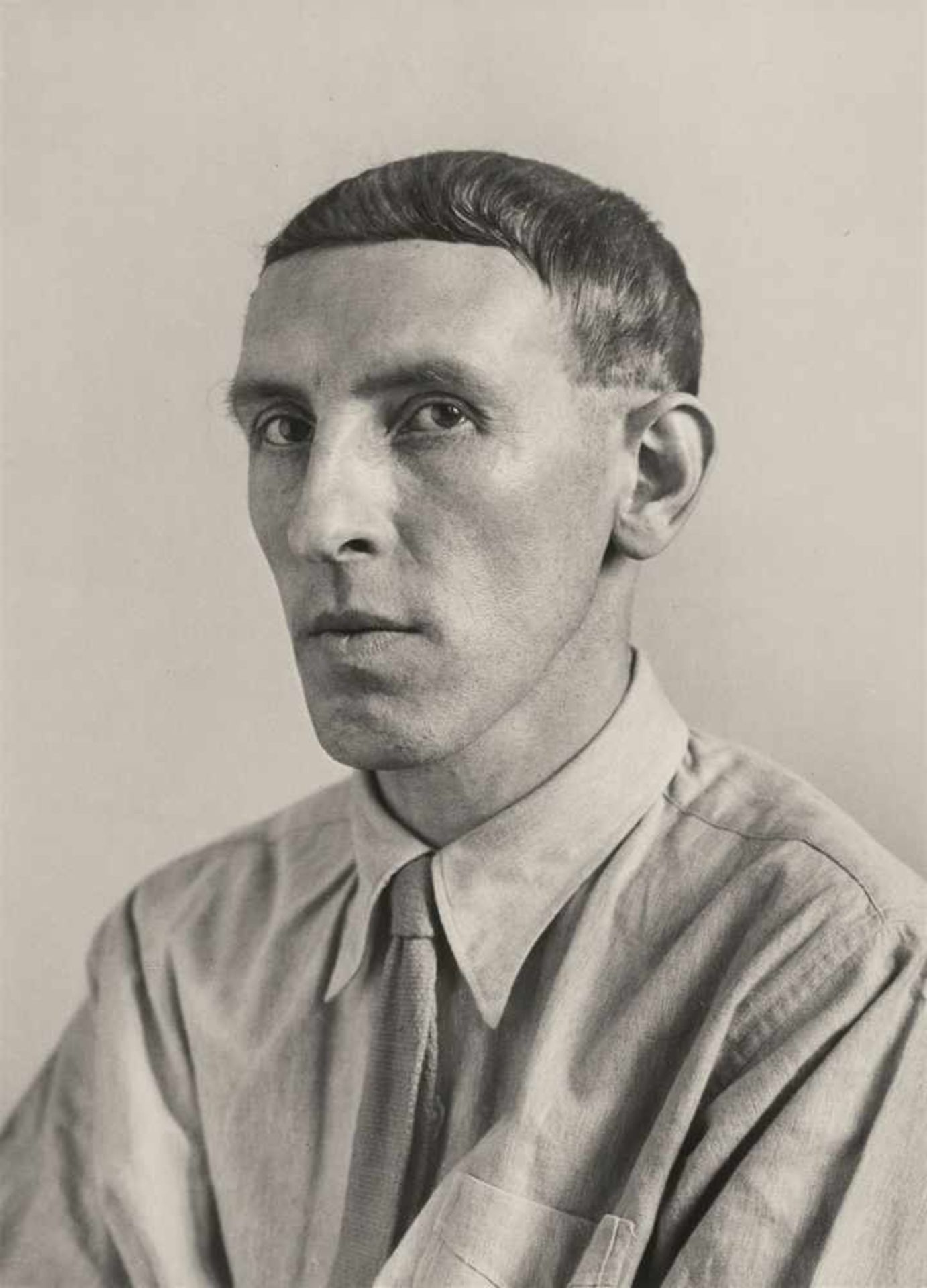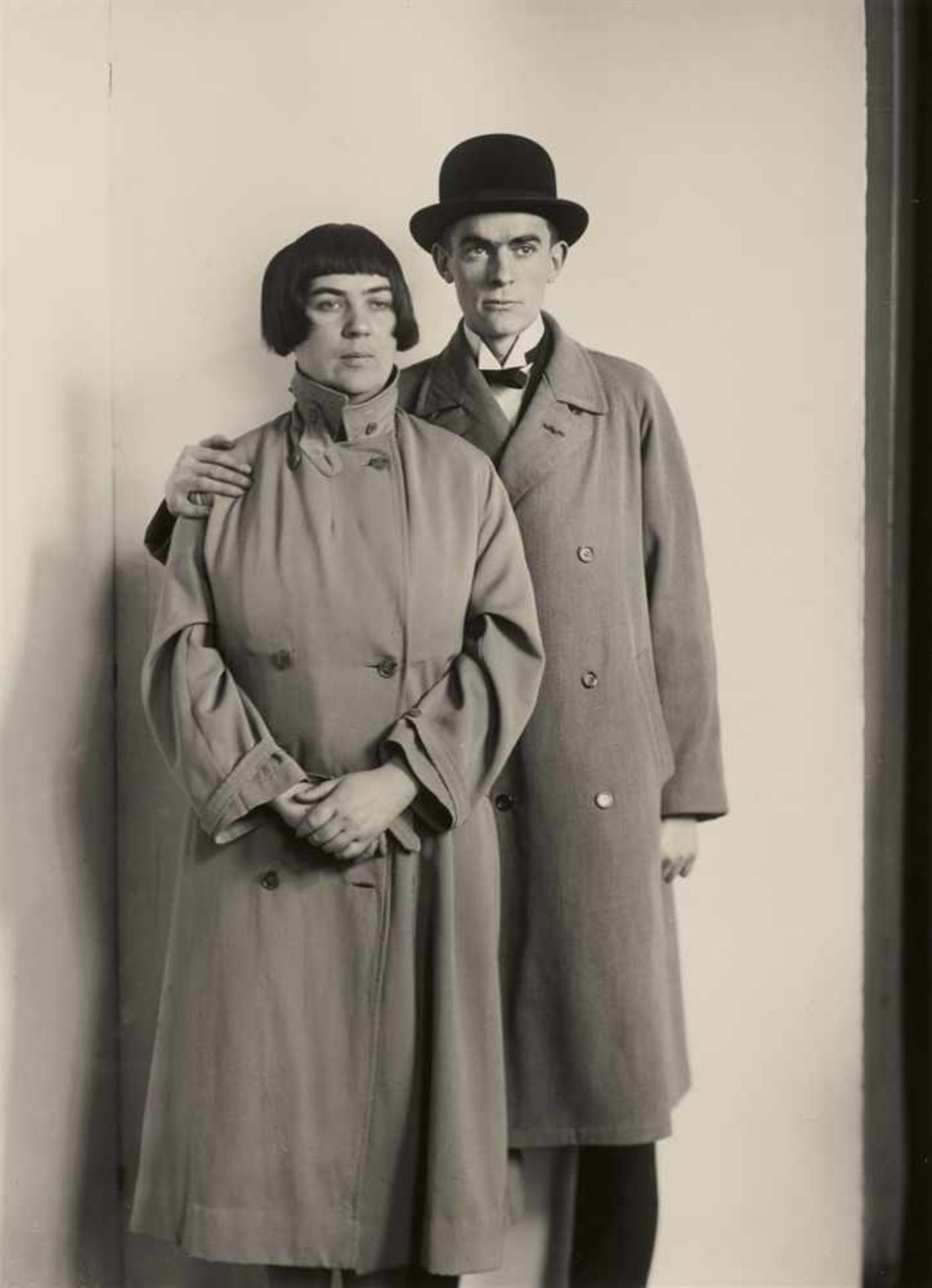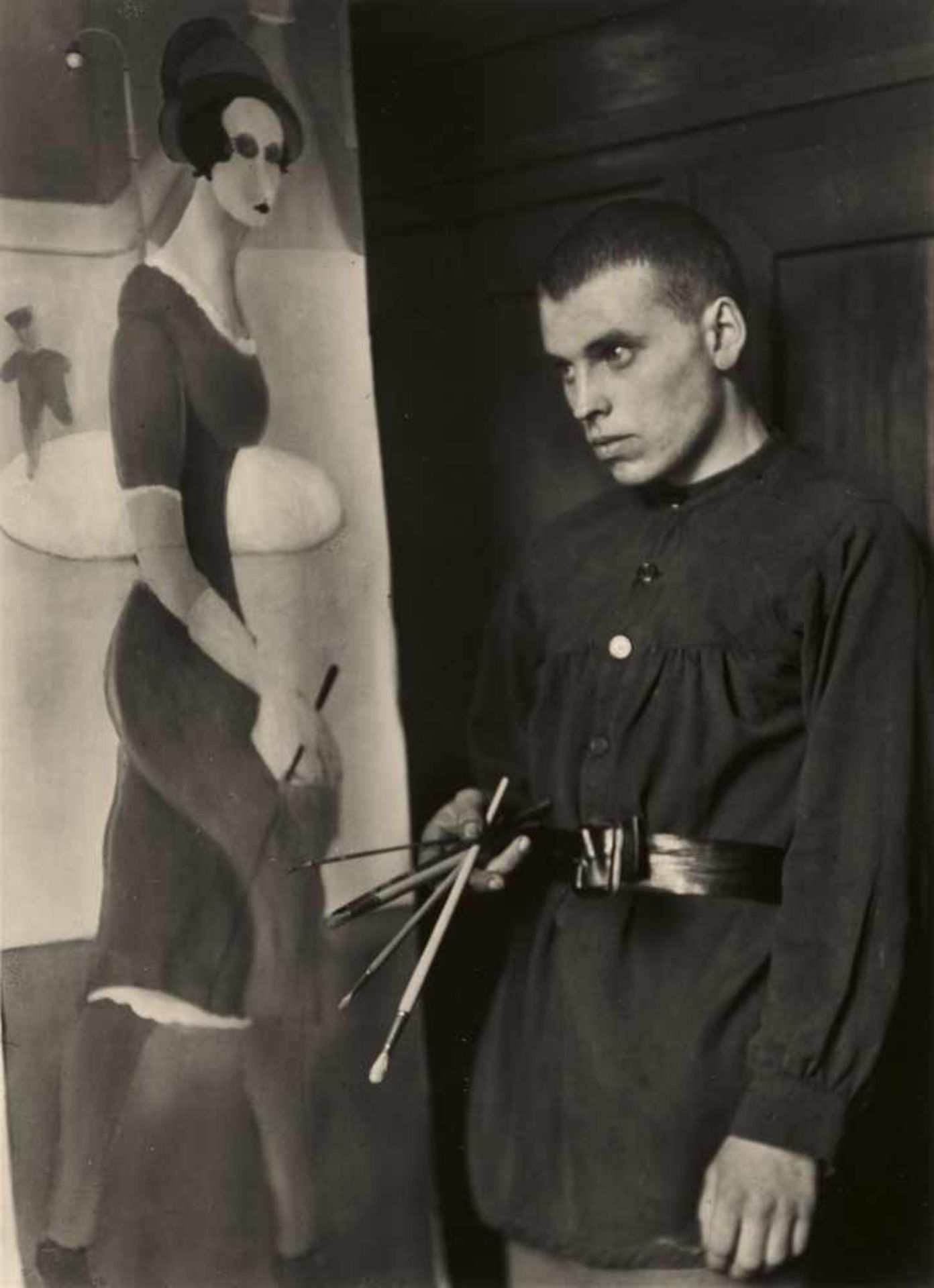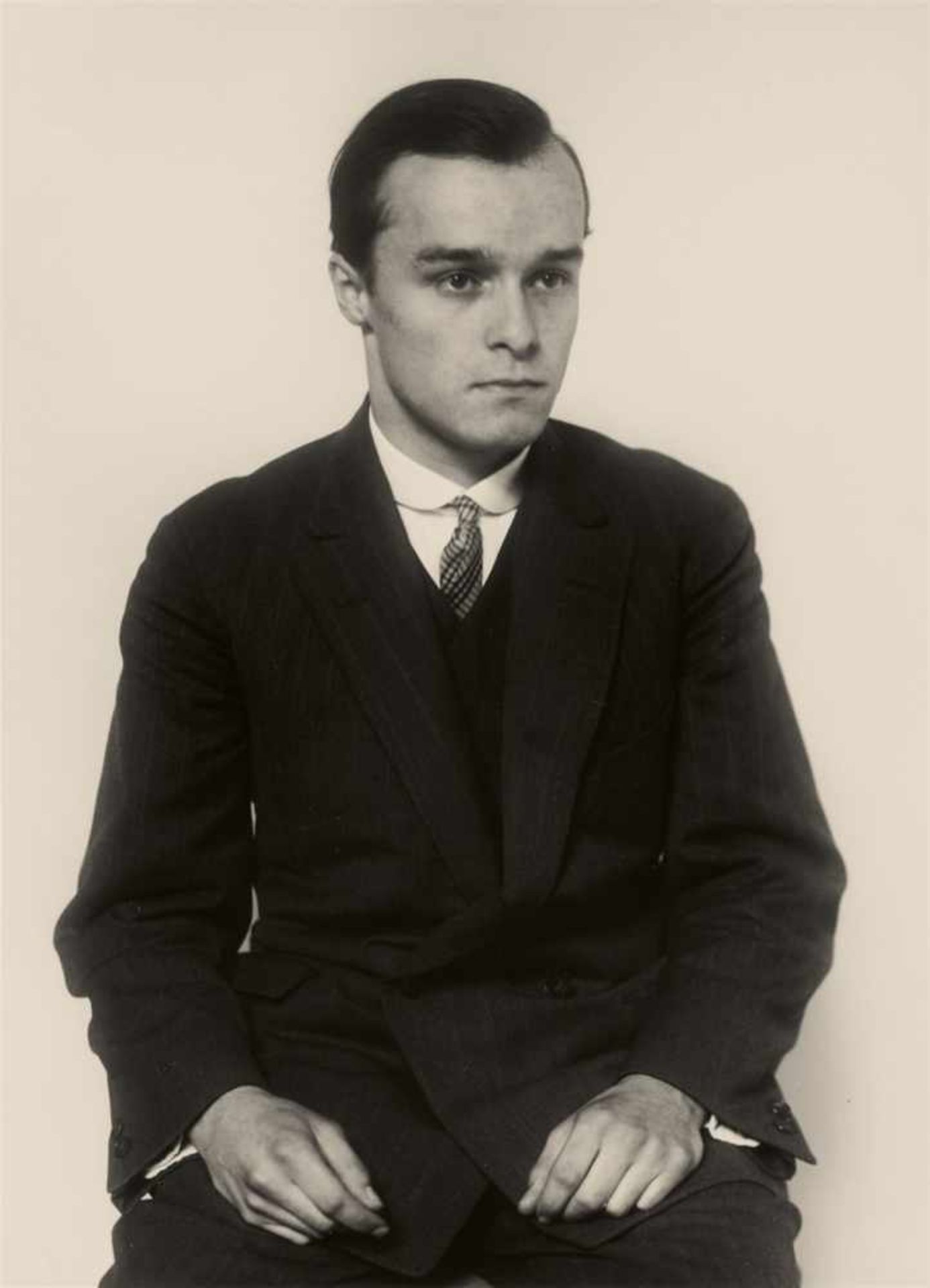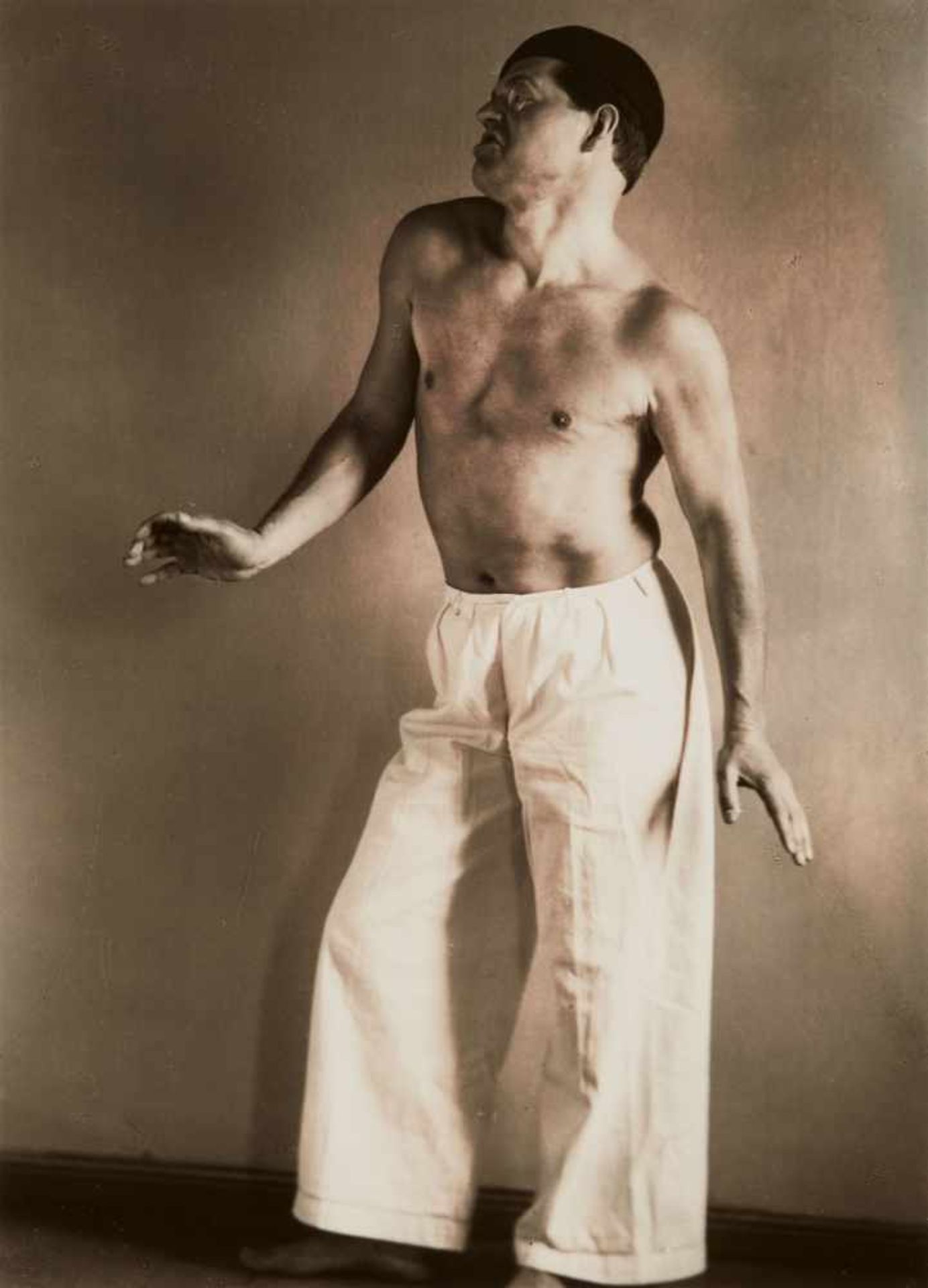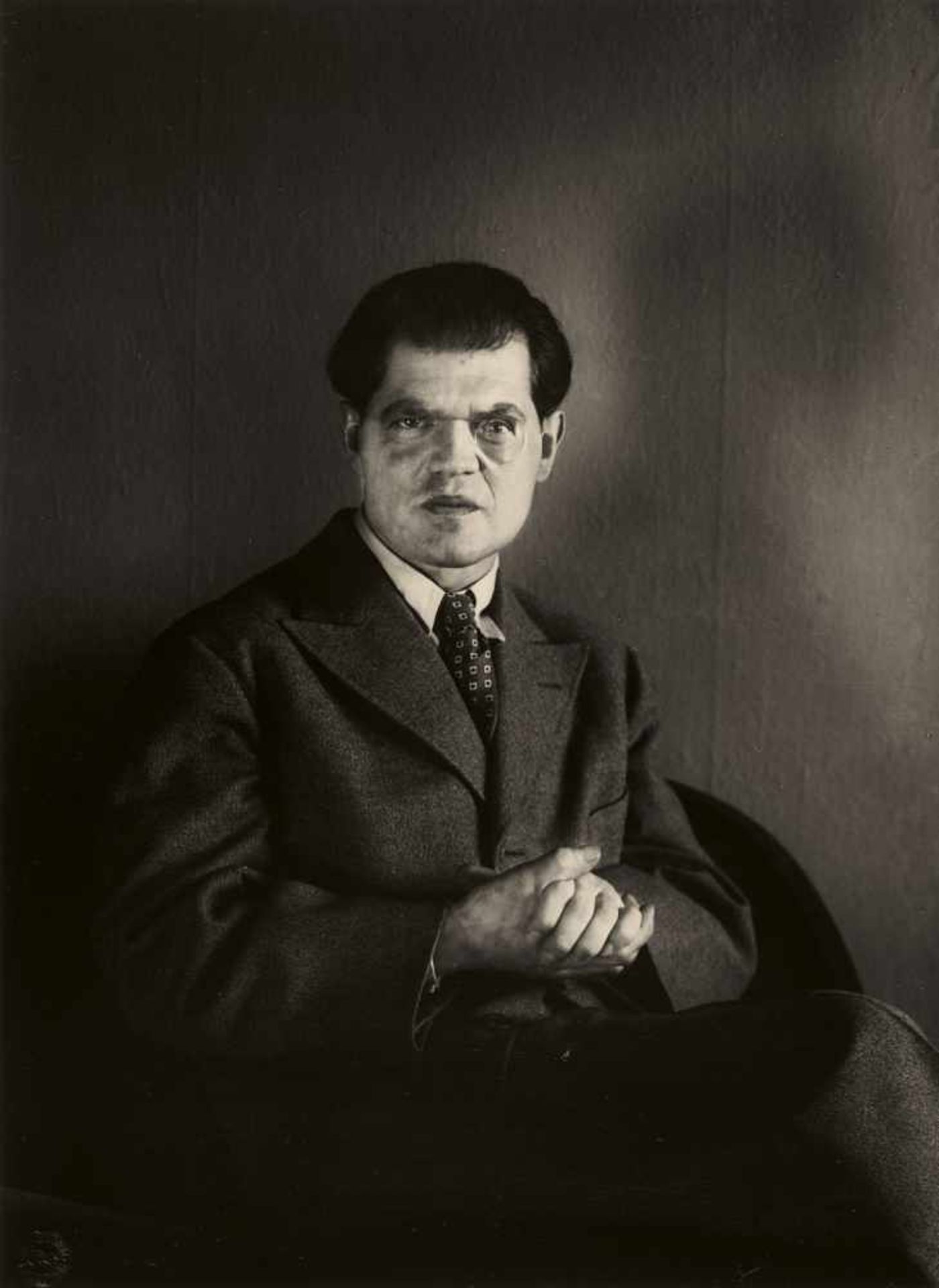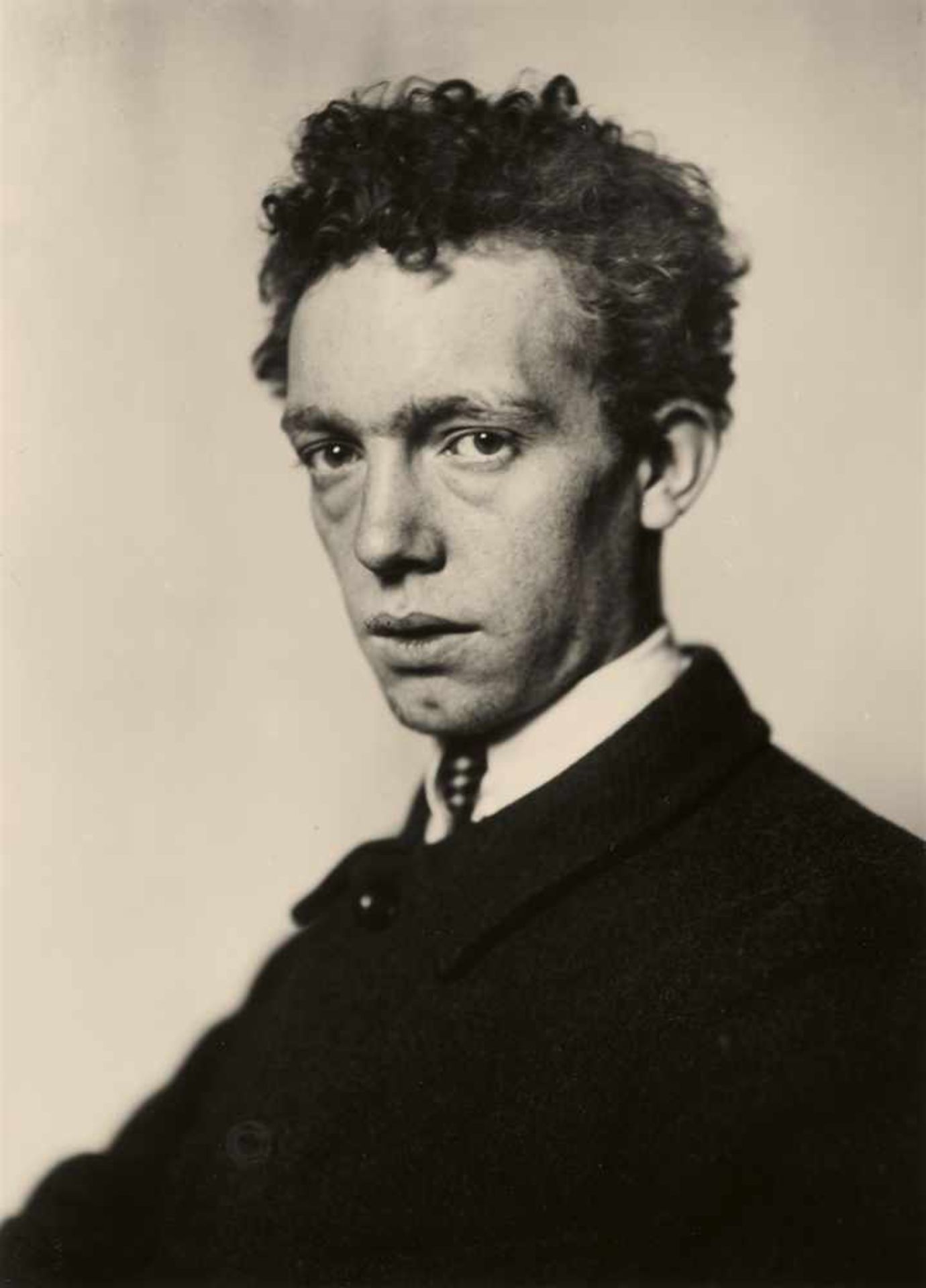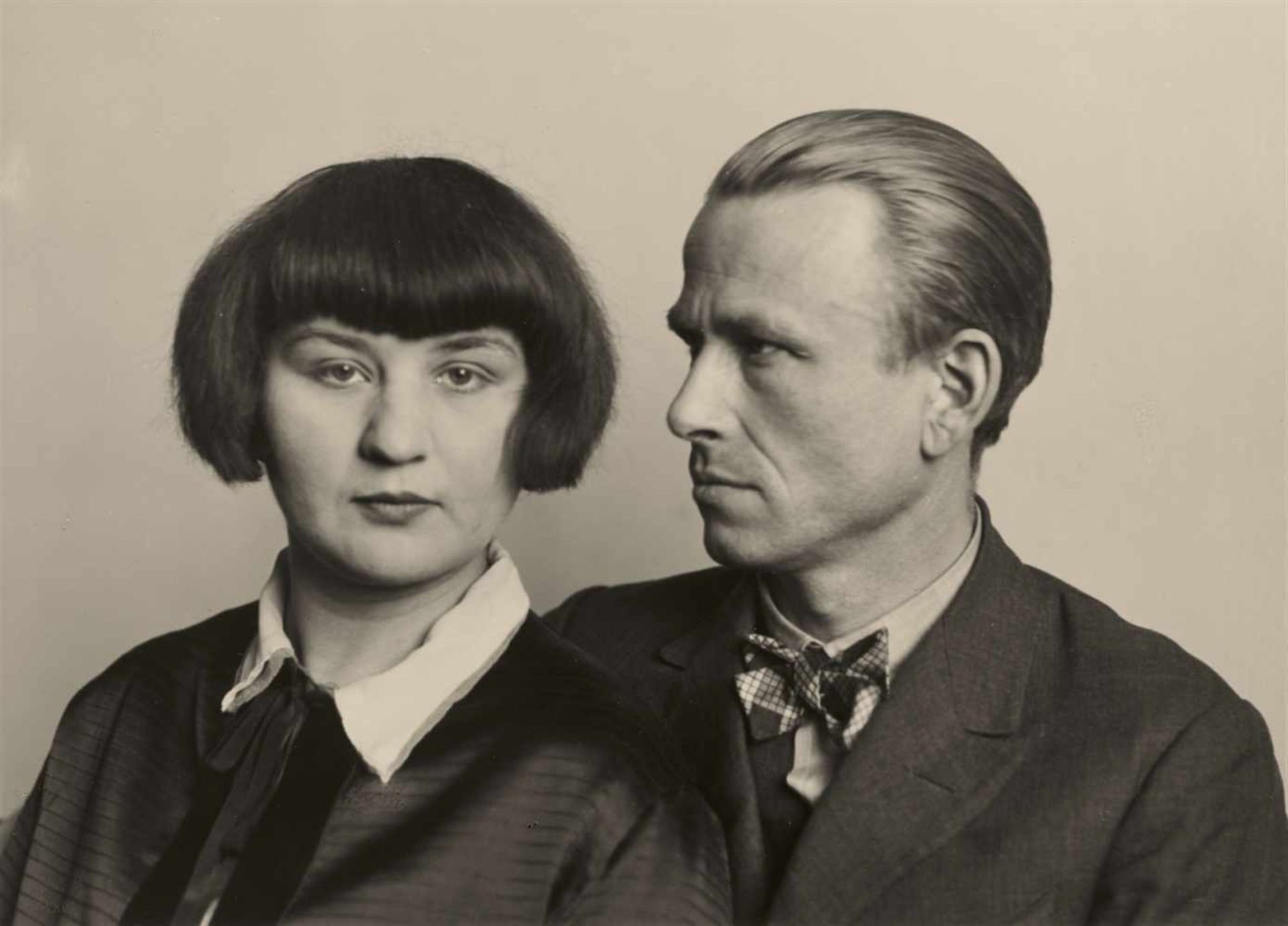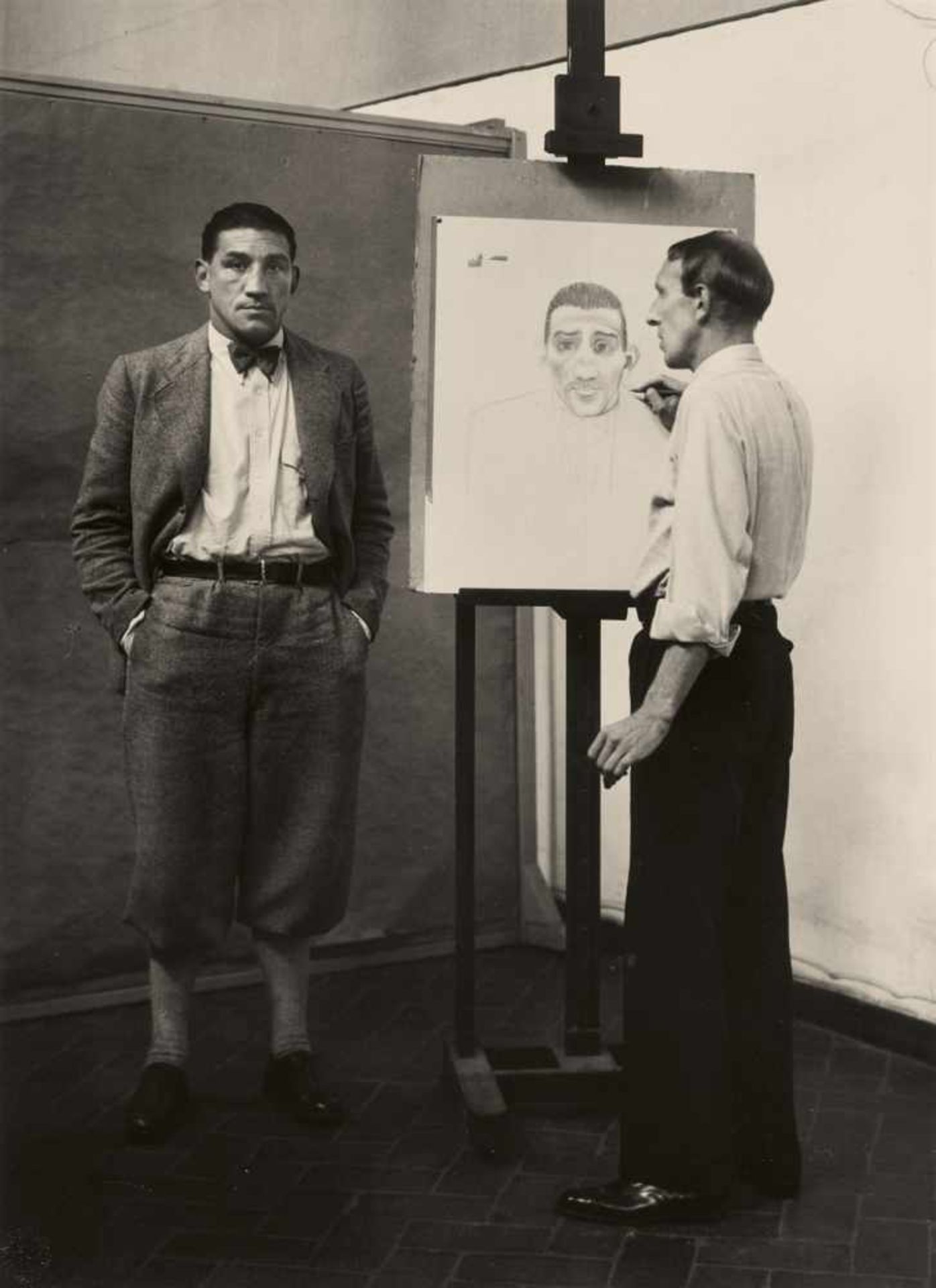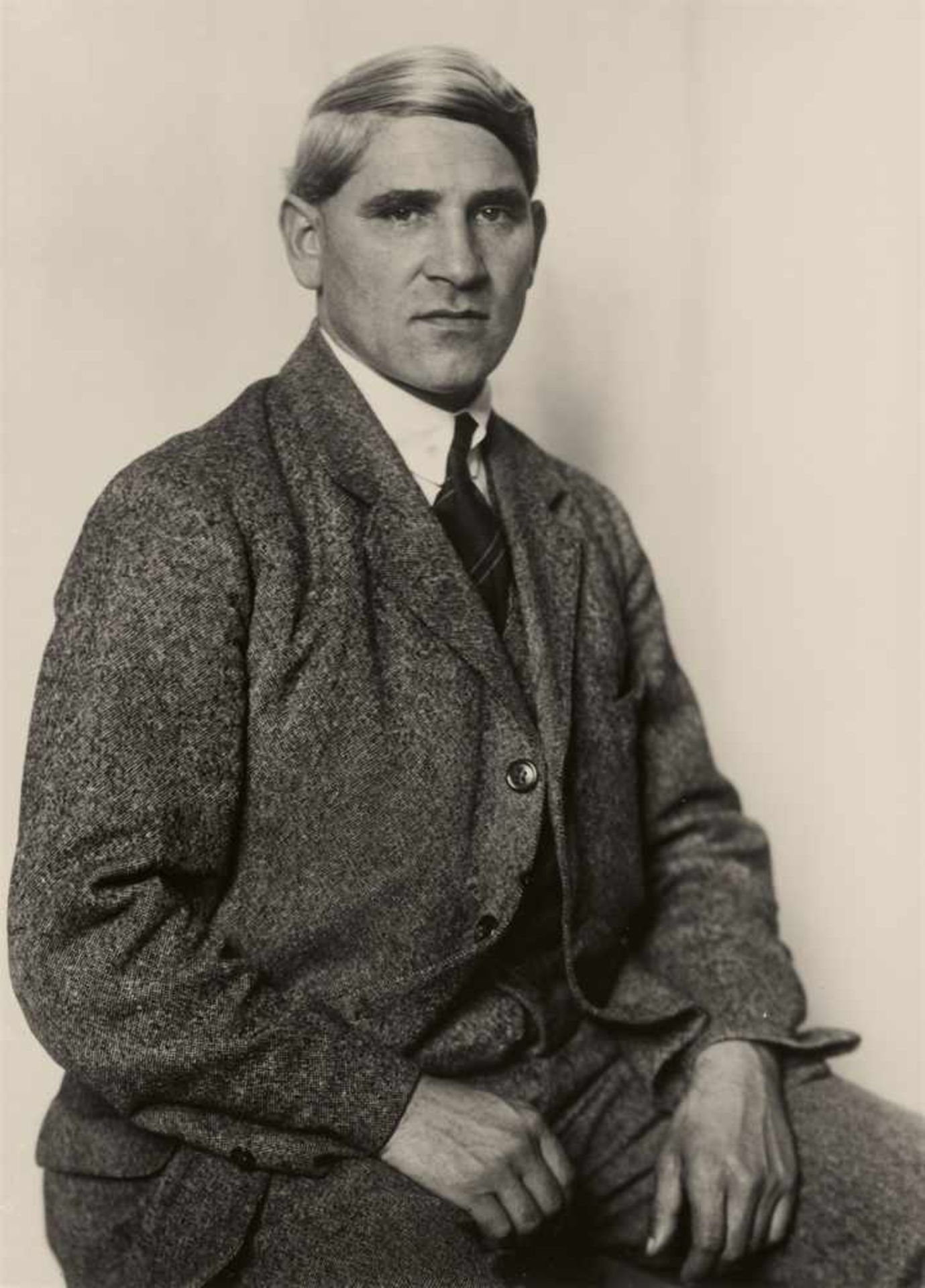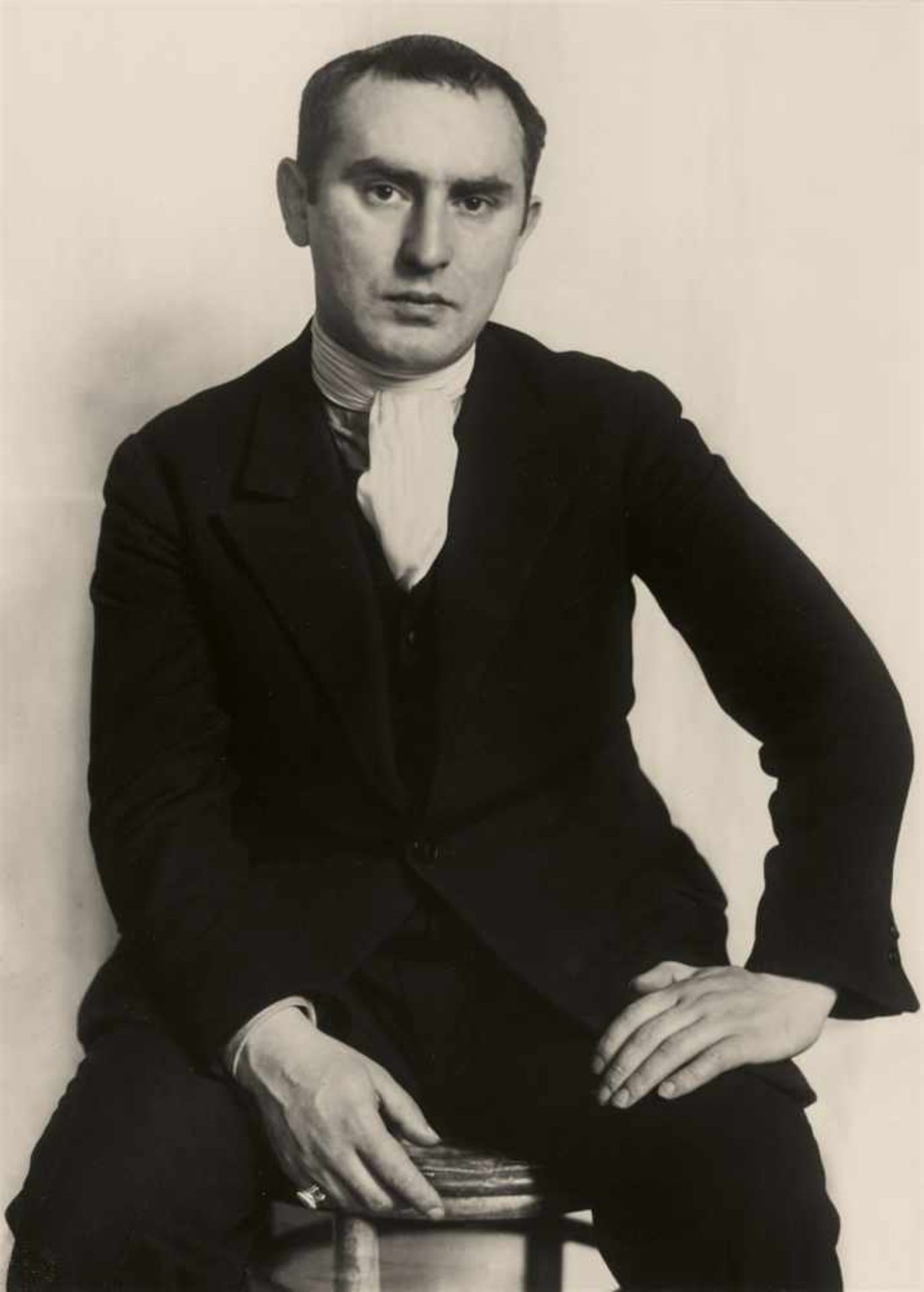5
August SanderKünstlerportraits<
August Sander
Künstlerportraits
Portfolio mit 12 Gelatinesilberabzügen 1974 von Gunther Sander. Jeweils 28,4 x 20,5 cm. Die Abzüge jeweils unten links mit Prägestempel des Photographen. Freiliegend in Passepartout montiert und auf Unterlagekarton aufgezogen, jeweils rückseitig mit Editionsstempel, darin mit Bleistift von Gunther Sander signiert, datiert und fortlaufend beziffert '1' bis '12'. Zusammen mit einem Deckblatt, dort maschinenschriftliche Werkangaben, in originaler Portfoliobox Exemplar 53/75. Edition Schirmer/Mosel, München.
Provenienz
Privatbesitz, Köln
Literatur
Lot 5 Sander
August Sander, Antlitz der Zeit. Sechzig Aufnahmen deutscher Menschen des 20. Jahrhunderts von August Sander, Berlin 1929 (Reprint München 1976), Tafel 50; Gunther Sander, August Sander. Menschen ohne Maske. Photographien 1906-1952, München 1976, mit Abbn.; Die Photographische Sammlung/SK-Stiftung Kultur (Hg.), Zeitgenossen. August Sander und die Kunstszene der 20er Jahre im Rheinland, Ausst.kat. Josef-Haubrich-Kunsthalle, Köln u.a., Göttingen 2000 (mit Abbn.); Die Photographische Sammlung/SK-Stiftung Kultur (Hg.), Menschen des 20. Jahrhunderts. Ein Kulturwerk in Lichtbildern eingeteilt in sieben Gruppen Band 4: Die Stände, München 2002, mit Abbn.; Die Photographische Sammlung/SK-Stiftung Kultur (Hg.), Menschen des 20. Jahrhunderts. Ein Kulturwerk in Lichtbildern eingeteilt in sieben Gruppen, Band 5: Die Künstler, München 2002, mit 1 Abb.; Die Photographische Sammlung/SK-Stiftung Kultur (Hg.), August Sander. Meisterwerke, München 2018, mit Abbn.
Innerhalb der Photographie des 20. Jahrhunderts nimmt das Werk August Sanders eine herausragende Stellung ein. Sein monumentales Portraitwerk Menschen des 20. Jahrhunderts wurde bereits von der zeitgenössischen Kritik begeistert aufgenommen, beeinflusste mehrere nachfolgende Photographengenerationen und wirkt aufgrund seiner konzeptuellen Ausrichtung bis in die heutige Zeit nach.
Mitte der 1920er Jahre begann Sander mit der Konzeption seines Lebensprojektes, dem die Absicht zugrunde lag, mittels photographischer Portraits von Menschen der unterschiedlichsten sozialen Schichten und Berufsgruppen die gesellschaftliche Struktur seiner Zeit offenzulegen. Den damaligen Berufsbildern und Sozialstrukturen entsprechend, gliederte er seine Studie in sieben Gruppen - „Der Bauer“, „Der Handwerker“, „Die Frau“, „Die Stände“, „Die Künstler“, „Die Großstadt“ und „Die letzten Menschen“ -, die insgesamt 45 Mappen umfassen sollten. Dass er innerhalb seiner Systematik die Künstler nicht, wie es denkbar gewesen wäre, in „Die Stände“ eingliederte, sondern ihnen eine eigene Gruppe widmete, verdeutlicht, welch hohen Stellenwert er ihnen innerhalb des gesellschaftlichen Kontextes beimaß. Es ist davon auszugehen, dass es Sanders persönliches Umfeld war, das zu dieser Gewichtung führte, stand er doch zu vielen der von ihm portraitierten Künstler in engem, ja sogar freundschaftlichem Kontakt. Insbesondere mit den Künstlern der Kölner Progessiven, darunter etwa Wilhelm Seiwert, Heinrich Hoerle, Anton Räderscheidt, Otto Freundlich und Gottfried Brockmann, gab es einen intensiven Austausch über künstlerische und gesellschaftspolitische Fragestellungen - Diskurse, die ihren Niederschlag nicht nur in seinem eige
Full description on lot-tissimo.com
August Sander
Künstlerportraits
Portfolio containing 12 gelatin silver prints, printed 1974 by Gunther Sander. Each print approx. 28.4 x 20.5 cm. The prints each with photographer's blindstamp lower left. Mounted individually under original mat and flushmounted to card, edition stamp, therein signed, dated and consecutively numbered '1' - '12' by Gunther Sander in pencil, on the reverse of the mounts. Together with flyleaf, thereon typewritten notes on the works, in original portfolio box. Print 53 from an edition of 75. Schirmer/Mosel edition, Munich.
Provenance
Private property, Cologne
Literature
August Sander, Antlitz der Zeit. Sechzig Aufnahmen deutscher Menschen des 20. Jahrhunderts von August Sander, Berlin 1929 (Munich 1976), plate 50; Gunther Sander, August Sander. Menschen ohne Maske. Photographien 1906-1952, Munich 1976, with ill.; Die Photographische Sammlung/SK-Stiftung Kultur (ed.), Zeitgenossen. August Sander und die Kunstszene der 20er Jahre im Rheinland, exhib.cat. Josef-Haubrich-Kunsthalle, Köln i.a., Göttingen 2000, with ill.; Die Photographische Sammlung/SK-Stiftung Kultur (ed.), Menschen des 20. Jahrhunderts. Ein Kulturwerk in Lichtbildern eingeteilt in sieben Gruppen, Vol. 4: Die Stände, Munich 2002, with ill.; Die Photographische Sammlung/SK-Stiftung Kultur (ed.), Menschen des 20. Jahrhunderts. Ein Kulturwerk in Lichtbildern eingeteilt in sieben Gruppen, Vol. 5: Die Künstler, Munich 2002, with 1 ill.; Die Photographische Sammlung/SK-Stiftung Kultur (ed.), August Sander. Meisterwerke, Munich 2018, with ill.
Within 20th century photography, August Sander's œuvre occupies a prominent position. His monumental portrait work People of the 20th Century had already been enthusiastically received by contemporary critics, influenced several subsequent generations of photographers, and, due to its conceptual orientation, continues to have a lasting influence to this day.
In the mid-1920s, Sander embarked on the conception of his life project, which was based on the intention of revealing the social structures of his time by means of photographic portraits of people from the most diverse social levels and occupational groups. IIn accordance with the occupational profiles and social structures of the time, he divided his study into seven groups - 'Der Bauer', 'Der Handwerker', 'Die Frau', 'Die Stände', 'Die Künstler', 'Die Großstadt', and 'Die letzten Menschen' - which were to comprise a total of 45 portfolios. The fact that he did not, as would have been conceivable, integrate the artists into 'Die Stände' within his system, but dedicated a group of his own to them, illustrates the high value he attached to them within the social context. It can be assumed that it was Sander's personal environment that led to this emphasis, since he was in close, even friendly contact with many of the artists he portrayed. There was vigorous interaction concerning artistic and socio-political questions in particular with the artists of the Kölner Progessiven, including Wilhelm Seiwert, Heinrich Hoerle, Anton Räderscheidt, Otto Freundlich, and Gottfried Brockmann -discourses that found their expression not only in his own œuvre, but conversely also in that of the other painters.
The relationship to his artist friends was of central importance for Sander's conception of the People of the 20th Century to the extent that it was based on an artistic strategy such as was concurrently applied in the work of Seiwert, Hoerle, and Brockmann. The artists mentioned also created portfolios with which they strove to visually capture the social structure of the Weimar Republic in typifying representations. 'What they exemplarily realised in their works through the medium of graphics, was elevated by Sander to the general principle of his work, which he systematically divided into groups and portfolios and subjected to a typological orientation by means of photography'. (Susanne Lange/Gabriele Conrath-Scholl, in: Die Photographische Sammlung / SK Stiftung Kultur (ed.), loc.cit., p. 13).
This portfolio of prints, which August Sander's son Gunther compiled from the original negatives, combines not only some of the photographer's most famous portraits of artists. With a view to what has been said, it can also be interpreted as a retrospective appreciation of the mutual artistic exchange from which a photographic work finally emerged that is unique in the history of photography.
August Sander
Künstlerportraits
Portfolio mit 12 Gelatinesilberabzügen 1974 von Gunther Sander. Jeweils 28,4 x 20,5 cm. Die Abzüge jeweils unten links mit Prägestempel des Photographen. Freiliegend in Passepartout montiert und auf Unterlagekarton aufgezogen, jeweils rückseitig mit Editionsstempel, darin mit Bleistift von Gunther Sander signiert, datiert und fortlaufend beziffert '1' bis '12'. Zusammen mit einem Deckblatt, dort maschinenschriftliche Werkangaben, in originaler Portfoliobox Exemplar 53/75. Edition Schirmer/Mosel, München.
Provenienz
Privatbesitz, Köln
Literatur
Lot 5 Sander
August Sander, Antlitz der Zeit. Sechzig Aufnahmen deutscher Menschen des 20. Jahrhunderts von August Sander, Berlin 1929 (Reprint München 1976), Tafel 50; Gunther Sander, August Sander. Menschen ohne Maske. Photographien 1906-1952, München 1976, mit Abbn.; Die Photographische Sammlung/SK-Stiftung Kultur (Hg.), Zeitgenossen. August Sander und die Kunstszene der 20er Jahre im Rheinland, Ausst.kat. Josef-Haubrich-Kunsthalle, Köln u.a., Göttingen 2000 (mit Abbn.); Die Photographische Sammlung/SK-Stiftung Kultur (Hg.), Menschen des 20. Jahrhunderts. Ein Kulturwerk in Lichtbildern eingeteilt in sieben Gruppen Band 4: Die Stände, München 2002, mit Abbn.; Die Photographische Sammlung/SK-Stiftung Kultur (Hg.), Menschen des 20. Jahrhunderts. Ein Kulturwerk in Lichtbildern eingeteilt in sieben Gruppen, Band 5: Die Künstler, München 2002, mit 1 Abb.; Die Photographische Sammlung/SK-Stiftung Kultur (Hg.), August Sander. Meisterwerke, München 2018, mit Abbn.
Innerhalb der Photographie des 20. Jahrhunderts nimmt das Werk August Sanders eine herausragende Stellung ein. Sein monumentales Portraitwerk Menschen des 20. Jahrhunderts wurde bereits von der zeitgenössischen Kritik begeistert aufgenommen, beeinflusste mehrere nachfolgende Photographengenerationen und wirkt aufgrund seiner konzeptuellen Ausrichtung bis in die heutige Zeit nach.
Mitte der 1920er Jahre begann Sander mit der Konzeption seines Lebensprojektes, dem die Absicht zugrunde lag, mittels photographischer Portraits von Menschen der unterschiedlichsten sozialen Schichten und Berufsgruppen die gesellschaftliche Struktur seiner Zeit offenzulegen. Den damaligen Berufsbildern und Sozialstrukturen entsprechend, gliederte er seine Studie in sieben Gruppen - „Der Bauer“, „Der Handwerker“, „Die Frau“, „Die Stände“, „Die Künstler“, „Die Großstadt“ und „Die letzten Menschen“ -, die insgesamt 45 Mappen umfassen sollten. Dass er innerhalb seiner Systematik die Künstler nicht, wie es denkbar gewesen wäre, in „Die Stände“ eingliederte, sondern ihnen eine eigene Gruppe widmete, verdeutlicht, welch hohen Stellenwert er ihnen innerhalb des gesellschaftlichen Kontextes beimaß. Es ist davon auszugehen, dass es Sanders persönliches Umfeld war, das zu dieser Gewichtung führte, stand er doch zu vielen der von ihm portraitierten Künstler in engem, ja sogar freundschaftlichem Kontakt. Insbesondere mit den Künstlern der Kölner Progessiven, darunter etwa Wilhelm Seiwert, Heinrich Hoerle, Anton Räderscheidt, Otto Freundlich und Gottfried Brockmann, gab es einen intensiven Austausch über künstlerische und gesellschaftspolitische Fragestellungen - Diskurse, die ihren Niederschlag nicht nur in seinem eige
Full description on lot-tissimo.com
August Sander
Künstlerportraits
Portfolio containing 12 gelatin silver prints, printed 1974 by Gunther Sander. Each print approx. 28.4 x 20.5 cm. The prints each with photographer's blindstamp lower left. Mounted individually under original mat and flushmounted to card, edition stamp, therein signed, dated and consecutively numbered '1' - '12' by Gunther Sander in pencil, on the reverse of the mounts. Together with flyleaf, thereon typewritten notes on the works, in original portfolio box. Print 53 from an edition of 75. Schirmer/Mosel edition, Munich.
Provenance
Private property, Cologne
Literature
August Sander, Antlitz der Zeit. Sechzig Aufnahmen deutscher Menschen des 20. Jahrhunderts von August Sander, Berlin 1929 (Munich 1976), plate 50; Gunther Sander, August Sander. Menschen ohne Maske. Photographien 1906-1952, Munich 1976, with ill.; Die Photographische Sammlung/SK-Stiftung Kultur (ed.), Zeitgenossen. August Sander und die Kunstszene der 20er Jahre im Rheinland, exhib.cat. Josef-Haubrich-Kunsthalle, Köln i.a., Göttingen 2000, with ill.; Die Photographische Sammlung/SK-Stiftung Kultur (ed.), Menschen des 20. Jahrhunderts. Ein Kulturwerk in Lichtbildern eingeteilt in sieben Gruppen, Vol. 4: Die Stände, Munich 2002, with ill.; Die Photographische Sammlung/SK-Stiftung Kultur (ed.), Menschen des 20. Jahrhunderts. Ein Kulturwerk in Lichtbildern eingeteilt in sieben Gruppen, Vol. 5: Die Künstler, Munich 2002, with 1 ill.; Die Photographische Sammlung/SK-Stiftung Kultur (ed.), August Sander. Meisterwerke, Munich 2018, with ill.
Within 20th century photography, August Sander's œuvre occupies a prominent position. His monumental portrait work People of the 20th Century had already been enthusiastically received by contemporary critics, influenced several subsequent generations of photographers, and, due to its conceptual orientation, continues to have a lasting influence to this day.
In the mid-1920s, Sander embarked on the conception of his life project, which was based on the intention of revealing the social structures of his time by means of photographic portraits of people from the most diverse social levels and occupational groups. IIn accordance with the occupational profiles and social structures of the time, he divided his study into seven groups - 'Der Bauer', 'Der Handwerker', 'Die Frau', 'Die Stände', 'Die Künstler', 'Die Großstadt', and 'Die letzten Menschen' - which were to comprise a total of 45 portfolios. The fact that he did not, as would have been conceivable, integrate the artists into 'Die Stände' within his system, but dedicated a group of his own to them, illustrates the high value he attached to them within the social context. It can be assumed that it was Sander's personal environment that led to this emphasis, since he was in close, even friendly contact with many of the artists he portrayed. There was vigorous interaction concerning artistic and socio-political questions in particular with the artists of the Kölner Progessiven, including Wilhelm Seiwert, Heinrich Hoerle, Anton Räderscheidt, Otto Freundlich, and Gottfried Brockmann -discourses that found their expression not only in his own œuvre, but conversely also in that of the other painters.
The relationship to his artist friends was of central importance for Sander's conception of the People of the 20th Century to the extent that it was based on an artistic strategy such as was concurrently applied in the work of Seiwert, Hoerle, and Brockmann. The artists mentioned also created portfolios with which they strove to visually capture the social structure of the Weimar Republic in typifying representations. 'What they exemplarily realised in their works through the medium of graphics, was elevated by Sander to the general principle of his work, which he systematically divided into groups and portfolios and subjected to a typological orientation by means of photography'. (Susanne Lange/Gabriele Conrath-Scholl, in: Die Photographische Sammlung / SK Stiftung Kultur (ed.), loc.cit., p. 13).
This portfolio of prints, which August Sander's son Gunther compiled from the original negatives, combines not only some of the photographer's most famous portraits of artists. With a view to what has been said, it can also be interpreted as a retrospective appreciation of the mutual artistic exchange from which a photographic work finally emerged that is unique in the history of photography.
30 Years of Photography at Lempertz - 30 Photographic Masterpieces / Photography
Auktionsdatum
Ort der Versteigerung
Für Kunsthaus Lempertz Versandinformtation bitte wählen Sie +49 (0)221 9257290.
Wichtige Informationen
3 % live surcharge plus VAT
Different terms on lot level
24.00 % buyer's premium on the hammer price
19.00 % VAT on buyer's premium and other charges; not indicated and not reclaimable; VAT margin scheme
24.00 % buyer's premium on the hammer price
7.00 % pre-paid importation VAT on the hammer price, only reclaimable in case of export to a country outside the EU
19.00 % VAT on buyer's premium and other charges; not indicated and not reclaimable; VAT margin scheme
19.00 % VAT on the hammer price
24.00 % buyer's premium on the hammer price
19.00 % VAT on buyer's premium
AGB
Conditions of Sale
1. The art auction house, Kunsthaus Lempertz (henceforth referred to as Lempertz), conducts public auctions in terms of § 383 paragraph 3 sentence 1 of the Civil Code as commissioning agent on behalf of the accounts of submitters, who remain -anonymous. With regard to its auctioneering terms and conditions drawn up in other languages, the German version remains the official one.
2. The auctioneer reserves the right to divide or combine any catalogue lots or, if it has special reason to do so, to offer any lot for sale in an order different from that given in the catalogue or to withdraw any lot from the sale.
3. All lots put up for sale may be viewed and inspected prior to the auction. The catalogue specifications and related specifications appearing on the internet, which have both been compiled in good conscience, do not form part of the contractually agreed to conditions. These specifications have been derived from the status of the information available at the time of compiling the catalogue. They do not serve as a guarantee in legal terms and their purpose is purely in the information they provide. The same applies to any reports on an item’s condition or any other information, either in oral or written form. Certificates or certifications from artists, their estates or experts relevant to each case only form a contractual part of the agreement if they are specifically mentioned in the catalogue text. The state of the item is generally not mentioned in the catalogue. Likewise missing specifications do not constitute an agreement on quality. All items are used goods.
The gold content of objects without fineness stamps are ascertained using an acid test. The size and quality of gemstones are ascertained within the settings, unless mentioned otherwise. Assessments of the clarity and colour of gemstones are subject to the subjective perception. Minor divergences from the values provided do not represent deficiencies. References to gemmological certifications are used purely for informational purposes, and do not provide a guarantee. The watches listed have been opened to be catalogued, but we cannot guarantee for their accuracy and function.
4. Warranty claims are excluded. In the event of variances from the catalogue -descriptions, which result in negation or substantial diminution of value or suitability, and which are reported with due justification within one year after handover, Lempertz nevertheless undertakes to pursue its rights against the seller through the courts; in the event of a successful claim against the seller, Lempertz will reimburse the buyer only the total purchase price paid. Over and above this, Lempertz undertakes to reimburse its commission within a given period of two years after the date of the sale if the object in question proves not to be authentic.
5. Claims for compensation as the result of a fault or defect in the object auctioned or damage to it or its loss, regardless of the legal grounds, or as the result of variances from the catalogue description or statements made elsewhere are excluded unless Lempertz acted with wilful intent or gross negligence; the liability for bodily injury or damages caused to health or life remains unaffected. In other regards, point 4 applies.
6. Submission of bids. Bids in attendance: The floor bidder receives a bidding number on presentation of a photo ID. Lempertz reserves the right to grant entry to the auction. If the bidder is not known to Lempertz, registration must take place 24 hours before the auction is due to begin in writing on presentation of a current bank reference. Bids in absentia: Bids can also be submitted either in writing, -telephonically or via the internet. The placing of bids in absentia must reach -Lempertz 24 hours before the auction to ensure the proper processing thereof. The item must be mentioned in the bid placed, together with ticket number and item description. In the event of ambiguities, the listed ticket number -becomes applicable. The placement of a bid must be signed by the applicant. The regulations regarding revocations and the right to return the goods in the case of long distance agreements (§ 312b – d of the Civil Code) do not -apply. Telephonic bids: Establishing and maintaining a connection cannot be vouched for. In submitting a bid placement, the bidder declares that he agrees to the recording of the bidding process. Bids via the internet: They will only be accepted by Lempertz if the bidder registered himself on the internet website beforehand. Lempertz will treat such bids in the same way as bids in writing.
7. Carrying out the auction. The hammer will come down when no higher bids are submitted after three calls for a bid. In extenuating circumstances, the auctioneer reserves the right to bring down the hammer or he can refuse to accept a bid. If several individuals make the same bid at the same time, and after the third call, no higher bid ensues, then the ticket becomes the deciding factor. The auctioneer can retract his acceptance of the bid and auction the item once more if a higher bid that was submitted on time, was erroneously overlooked and immediately queried by the bidder, or if any doubts regarding its acceptance arise. Bids are only played to an absolute maximum by Lempertz if this is deemed necessary to outbid another bid. The auctioneer can bid on behalf of the submitter up to the agreed limit, without revealing this and irrespective of whether other bids are submitted. Even if bids have been placed and the hammer has not come down, the auctioneer is only liable to the bidder in the event of premeditation or gross negligence.
8. Once a lot has been knocked down, the successful bidder is obliged to buy it. If a bid is accepted conditionally, the bidder is bound by his bid until four weeks after the auction unless he immediately withdraws from the conditionally accepted bid. From the fall of the hammer, possession and risk pass directly to the buyer, while ownership passes to the buyer only after full payment has been received.
9. Up to a hammer price of € 400.000.- a premium of 24 % calculated on the hammer price plus 19 % value added tax calculated (VAT) on the surcharge only is levied. The premium will be reduced to 20 % (plus VAT) on any amount surpassing € 400.000 (margin scheme). On lots which are characterized by ** an additional 7 % for import tax will be added. On lots which are characterised by an *, the buyer shall pay a premium of 24 % on a hammer price up to € 400.000 and 20 % on the surpassing amount; onto this (hammer price and premium) the statutory VAT of 19 % will be added (regular scheme). Exports to third (i.e. non-EU) countries will be exempt from VAT, and so will be exports made by companies from other EU member states if they state their VAT identification number. For original works of art, whose author died after 31.12.1943, a charge of 1,9 % on the hammer price will be levied for the droit de suite. The maximum charge is € 12.500.-. If a buyer exports an object to a third country personally, the VAT will be refunded, as soon as Lempertz receives the export and import papers. All invoices issued on the day of auction or soon after remain under provision.
10. Successful bidders attending the auction in person shall forthwith upon the purchase pay to Lempertz the final price (hammer price plus premium and VAT) in Euro. Payments by foreign buyers who have bid in writing or by proxy shall also be due forthwith upon the purchase, but will not be deemed to have been delayed if received within ten days of the invoice date. Bank transfers are to be exclusively in Euros. The request for an alteration of an auction invoice to a person other than the bidder has to be made immediately after the auction. Lempertz however also reserves the right to refuse such a request if it is deemed appropriate.
11. In the case of payment default, Lempertz will charge interest on the outstanding amount at a rate of 1 % of the gross price per month or part month. If the buyer defaults in payment, Lempertz may at its discretion insist on performance of the purchase contract or, after allowing a period of grace, claim damages for non-performance. In the latter case, Lempertz may determine the amount of the damages by putting the lot or lots up for auction again, in which case the defaulting buyer will bear the amount of any reduction in the proceeds compared with the earlier auction, plus the cost of resale, including the premium.
12. Buyers must take charge of their purchases immediately after the auction. Once a lot has been sold, the auctioneer is liable only for wilful intent or gross negligence. Lots will not, however, be surrendered to buyers until full payment has been received. Without exception, shipment will be at the expense and risk of the buyer. Purchases which are not collected within four weeks after the auction may be stored and insured by Lempertz on behalf of the buyer and at its expense in the premises of a freight agent. If Lempertz stores such items itself, it will charge 1 % of the hammer price for insurance and storage costs.
13. As far as this can be agreed, the place of performance and jurisdiction is Cologne. German law applies; the provisions of the United Nations Convention on Contracts for the International Sale of Goods, CISG are not applicable. Should any provision herein be wholly or partially ineffective, this will not affect the validity of the remaining provisions.
Henrik Hanstein, sworn public auctioneer
Takuro Ito, Auctioneer


























